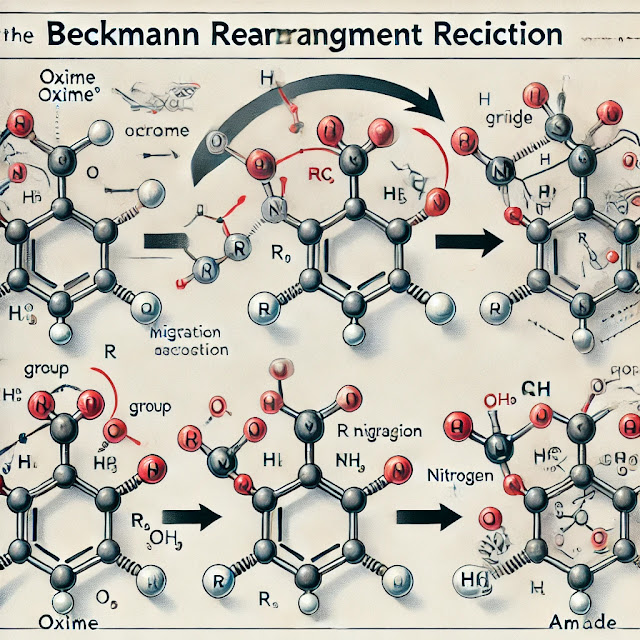The Beckmann rearrangement is a chemical reaction that involves the conversion of oximes into amides. This reaction is catalyzed by acids and is particularly useful in organic synthesis for creating amides from carbonyl compounds. Here’s a detailed look at its mechanism and synthetic applications:
Mechanism
Protonation of the Oxime:
- The reaction begins with the protonation of the oxime (R–C=N–OH) by an acid catalyst, forming a positively charged oxime species. This step increases the electrophilicity of the carbonyl group.
Formation of the Nitrenium Ion:
- The protonated oxime then undergoes a rearrangement where the nitrogen atom (N) migrates to the adjacent carbonyl carbon, forming a nitrenium ion intermediate. This involves the cleavage of the C–O bond and the formation of a new C–N bond.
Ring Closure and Formation of the Amide:
- The nitrenium ion intermediate is unstable and quickly reacts with water or another nucleophile, resulting in the formation of a carbonyl compound and an amide. The amide is the final product of the Beckmann rearrangement.
Synthetic Applications
Synthesis of Amides:
- The Beckmann rearrangement is a useful method for synthesizing amides from oximes. This is particularly useful in organic synthesis when direct methods to form amides are not feasible or are less efficient.
Preparation of Lactams:
- The rearrangement can be used to prepare lactams from cyclic oximes. This is important in the synthesis of various cyclic compounds, including some drugs and natural products.
Functional Group Interconversion:
- The reaction is a useful tool for functional group interconversion. For instance, it allows the transformation of ketones into amides, which can then be further manipulated in subsequent synthetic steps.
Design of Novel Compounds:
- By using the Beckmann rearrangement, chemists can design and synthesize novel compounds with specific functionalities. This is valuable in the development of new materials and pharmaceuticals.
Pharmaceutical Chemistry:
- In drug development, the Beckmann rearrangement can be employed to introduce or modify amide groups in pharmaceutical molecules, contributing to the optimization of drug properties and activities.
In summary, the Beckmann rearrangement is a versatile and valuable reaction in organic chemistry, facilitating the formation of amides and other nitrogen-containing compounds from oximes, with numerous applications in both industrial and academic settings.












0 Comments
Thanks for your feedback, ll get back to you soon